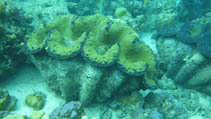Tridacna gigas (Linnaeus, 1758)
Giant clam| Native range | All suitable habitat | Point map | Year 2050 |

|
| This map was computer-generated and has not yet been reviewed. |
| Tridacna gigas AquaMaps Data sources: GBIF OBIS |
Classification / Names Common names | Synonyms | CoL | ITIS | WoRMS
Bivalvia | Cardiida | Cardiidae
Environment: milieu / climate zone / depth range / distribution range Ecology
Benthic; depth range 0 - 35 m (Ref. 75831). Tropical; 23°C - 30°C (Ref. 102835); 38°N - 29°S, 92°E - 178°W
Distribution Countries | FAO areas | Ecosystems | Occurrences | Introductions
Indo-Pacific: from Myanmar then east to Wallis and Futuna, north to Japan and south to western Australia. Introduced beyond Wallis and Futuna in the Pacific.
Length at first maturity / Size / Weight / Age
Maturity: Lm ?, range 25 - 35 cm Max length : 137 cm SHL male/unsexed; (Ref. 99323); common length : 80.0 cm SHL male/unsexed; (Ref. 348); max. published weight: 500.0 kg (Ref. 81839)
Short description Morphology
It is white and fan-shaped with deep radiating ribs.
Known to be the largest bivalve mollusks that exist. Exploited for its meat and shell, this species has recently become nearly extinct within an important part of its range, due to over collecting. Trials of aquaculture under progress for the restocking of reefs and local farming (Ref. 348). Facultative planktotroph. It has an established symbiotic relationship with a dinoflagellate algae (zooxanthellae) which allows them to survive. It ingests the algae at an early stage and the latter propagates in the gut (Ref. 100719).
Life cycle and mating behavior Maturity | Reproduction | Spawning | Eggs | Fecundity | Larvae
Becomes simultaneous hermaphrodite in its later years. Spawning is seasonal, based on its northern and southern limits of distribution (Ref. 100714).
Main reference
References | Coordinator | Collaborators
SAUP Database. 2006. (Ref. 356)
IUCN Red List Status (Ref. 130435)
Vulnerable (VU) (A2cd); Date assessed: 01 August 1996
CITES status (Ref. 108899)
Appendix II: International trade monitored
CMS (Ref. 116361)
Not Evaluated
Threat to humans
Human uses
Fisheries: commercial; aquaculture: commercial
FAO - Aquaculture: production; | FishSource | Sea Around Us
Tools
More information
Internet sources
BHL | BOLD Systems | CISTI | DiscoverLife | FAO(; publication : search) | Fishipedia | GenBank (genome, nucleotide) | GloBI | Gomexsi | Google Books | Google Scholar | Google | PubMed | Tree of Life | Wikipedia (Go, Search) | Zoological Record
Estimates based on models
Preferred temperature
(Ref. 115969): 24.8 - 29.3, mean 28.6 (based on 2805 cells).
Resilience
(Ref. 69278):
Low, minimum population doubling time 4.5 - 14 years (K=0.07-0.2).
Price category
(Ref. 80766):
Unknown.
Nutrients: Calcium = 149 [71, 228] mg/100g; Iron = 8.53 [1.95, 15.11] mg/100g; Protein = 9.88 [8.64, 11.12] %; Omega3 = 0.313 [0.202, 0.423] g/100g; Selenium = 61 [50, 72] μg/100g; VitaminA = 0 μg/100g; Zinc = 2.04 [0.56, 3.51] mg/100g (wet weight).



